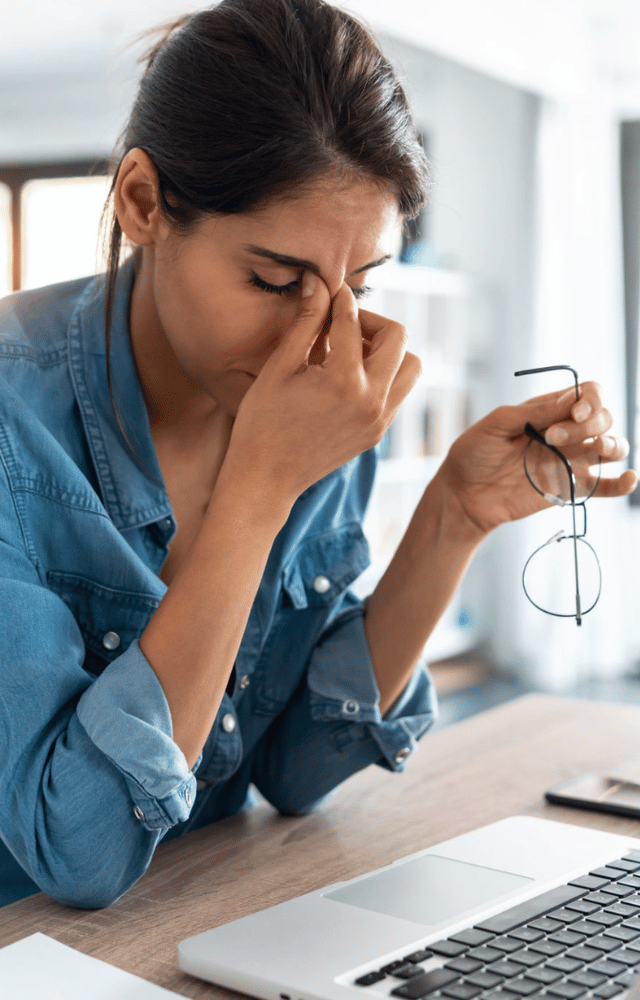Get 20% off 2 or more full priced Baxters or Wellbeing products! Add another full priced item below and a 20% discount will be applied to your overall order at checkout. That's right, 20% OFF your order!
Choose a category


What is eye strain?
20.04.2023
Eye strain, also known as asthenopia, is a common issue faced by many Australians due to the increased use of digital devices such as smartphones, computers, and tablets. Recent studies have shown that approximately 65% of Australian adults experience symptoms of eye strain, which include headaches, blurred vision, dry eyes, and neck or shoulder pain. This widespread issue has been primarily attributed to prolonged screen time and insufficient breaks during work or leisure activities.
Understanding eye strain
Eye strain occurs when your eyes become fatigued due to overuse, resulting in discomfort, redness, and other symptoms. While eye strain is not a severe condition, it can lead to discomfort and decreased productivity. Prolonged eye strain can also worsen existing eye conditions, such as myopia (nearsightedness) and presbyopia (age-related farsightedness).
Causes of eye strain
1/ Prolonged Screen Time: Spending extended periods staring at digital screens, such as computers, smartphones, and televisions, is a leading cause of eye strain. The close proximity and the need for constant focusing contribute to eye strain.
2/ Reading: Reading for long periods, especially in low light, can lead to eye strain due to the need for continuous focusing and adjusting to the text.
3/ Driving: Extended driving, especially at night, can cause eye strain as the eyes must continually adapt to changing light conditions and distances.
4/ Inadequate Lighting: Poor lighting can force the eyes to work harder, leading to strain.
5/ Incorrect Prescription: Wearing glasses or contact lenses with an incorrect prescription can cause eye strain, as the eyes struggle to compensate for the error.
6/ Uncorrected Vision Problems: Vision problems, such as astigmatism or presbyopia, can lead to eye strain if left uncorrected.
How to Recognise Eye Strain
Symptoms of eye strain can vary, but some common signs include:
Sore or tired eyes
Dry or watery eyes
Itching or burning sensations
Blurred or double vision
Sensitivity to light
Difficulty focusing on nearby objects
Headaches or migraines
Neck, shoulder, or back pain
Ways to Treat and Prevent Eye Strain
The 20-20-20 rule: Every 20 minutes, take a 20-second break and look at something 20 feet away. This helps relax your eye muscles and reduces eye strain.
Adjust your screen: Position your computer monitor or device screen about an arm's length away from your eyes and slightly below eye level. This reduces the strain on your eyes and neck.
Proper lighting: Ensure that your workspace has appropriate lighting to avoid glare and shadows. Avoid using devices in complete darkness or under excessively bright lights.
Blink frequently: Blinking helps keep your eyes moist and reduces the risk of dryness and irritation. Make a conscious effort to blink more often, especially when using digital devices.
Modify screen settings: Adjust your screen settings, such as brightness, contrast, and text size, to make it easier for your eyes to focus.
Wear blue light glasses: Blue light glasses contain lenses that are designed to filter out or block a significant portion of the blue light emitted by digital devices, such as computers, smartphones, and tablets. Prolonged exposure to blue light has been linked to digital eye strain, which can manifest as symptoms like dryness, discomfort, and even disrupted sleep patterns. By reducing the amount of blue light that reaches the eyes, blue light glasses can help minimise eye fatigue, enhance visual comfort, and maintain the overall health of the eyes.
Ergonomic workspace: Set up an ergonomic workspace with a comfortable ergonomic chair and stand up desk desk at the correct height. This can help minimise neck, shoulder, and back discomfort associated with eye strain.
Eye exercises: Practice eye exercises or palming techniques to relax and refresh your eyes.
Eye strain is a common issue in today's digital age, but with the right preventative measures and treatments, you can minimize its impact on your life. By understanding the causes of eye strain, identifying its symptoms, and employing effective treatments, you can maintain your eye health and enjoy a more comfortable visual experience. Remember, if your symptoms persist or worsen, consult an eye care professional for a comprehensive evaluation.

